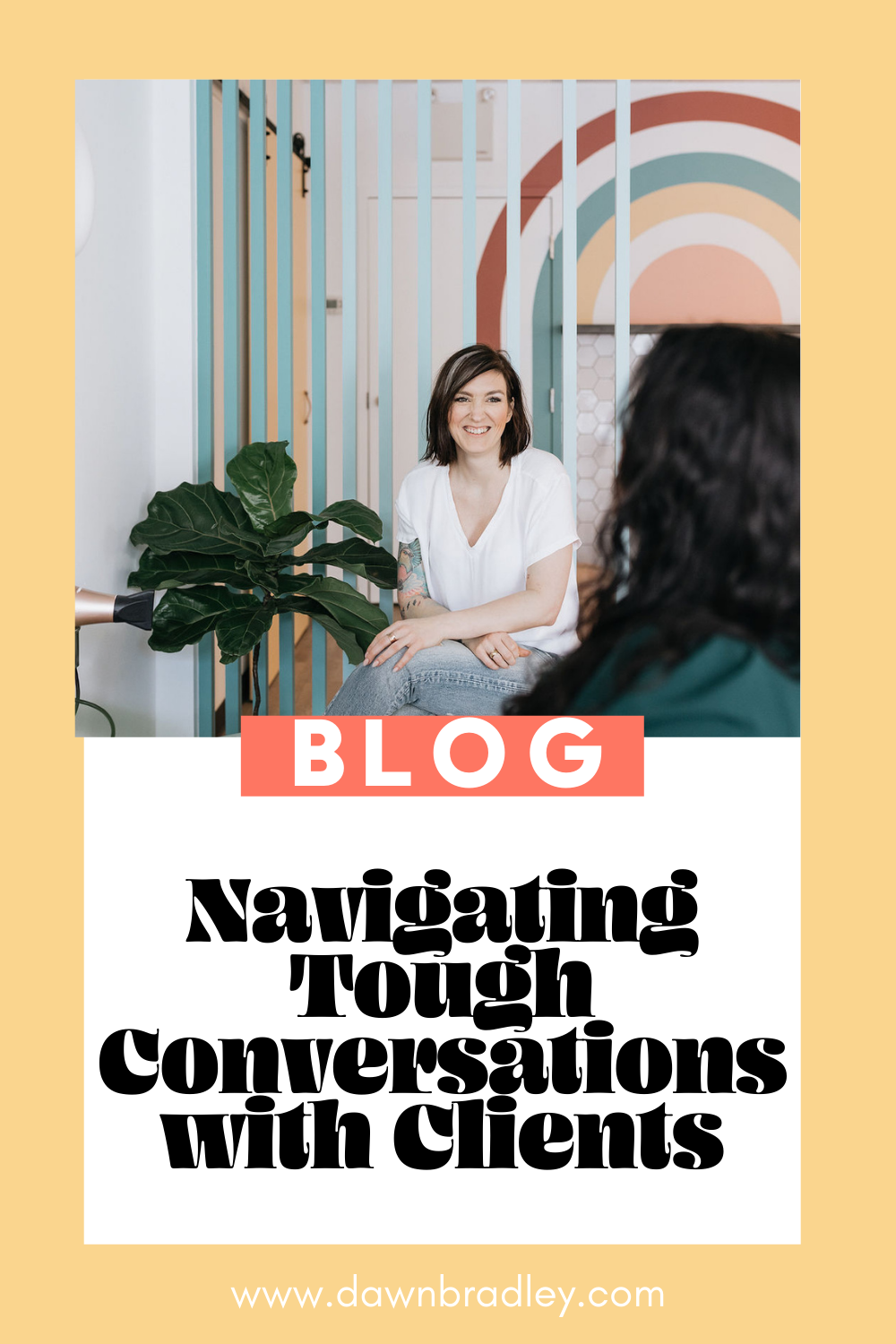subscribe & listen on your favorite app!
“I can’t control how it goes, all I can control is how I start the conversation”
Is the thought of having tough conversations with clients keeping you up at night?
I have a special topic that is going to show you how to shake the nerves of tough conversations with clients
Keep reading and you’ll walk away with knowing how to:
-
Shake the nerves that come with difficult conversations
-
Approach different tough situations
-
Navigate conversations that go sideways
P.S I have something very exciting in the works and I am spilling the beans… The Build Your Business Bootcamp is coming up in just a few short weeks in January! The Build Your Business Bootcamp is a 5-day FREE challenge to help you attract clients you love, set boundaries, get organized and set your prices properly. I will be personally guiding you through all the good stuff. You in? Join the FREE challenge Facebook group RIGHT HERE. (Don’t be like me and say you’ll do it later, cause you’ll forget, so go ahead and request to join right now.) I won’t be opening the group until mid-January but this will ensure you’re in when we start. This is gonna be SO good!
I can’t even begin to tell you how often I’ve wished for a crystal ball so I could see into the future. So I could watch myself have those tough conversations and know exactly how it was going to pan out.
Because I’ve yet to receive a crystal ball I end up falling into the “spider web of thoughts” trying to preplan my way through entire conversations. You know the “if I say this then they’ll say that, but if they say that then I’ll say this” scenarios that keep you awake until the middle of the night?
Of course, in the end, I’ll be too nervous to ever bring it up anyway.
Let’s be honest, we all have conversations that we wish we could run away from. That someone else will deal with. Right?
What if I told you having those conversations doesn’t have to be so hard? Yup, you heard me right. In fact, I now welcome these situations in my life.
And if you’re like “what the heck, Dawn? How is that even possible?” then you’re gonna wanna keep reading as I share…
The Simple Way to Shake the Nerves of Having Tough Conversations
How to Shake the Nerves
We all get nervous. Okay, there might be a few people who have a special gene where they don’t get nervous. But for the most part, we all experience nerves.
Whether you’re dealing with a client who shows up late, who keeps no-showing you, raising your prices or wanting to fire a client; emotions are bound to come up.
The first step is to admit to yourself that you’re having these emotions. Oftentimes we’re unwilling to admit to ourselves how we’re actually feeling (especially when it comes to the not-so-fun emotions).
Ask yourself why you’re feeling the way you are. What is causing the anxiety, the fear, the anger?
Then, and this is the most important part, allow yourself to fully feel those feelings.
More often than not we try to run away from the uncomfortable feelings because, well, they’re uncomfortable. Sitting in the discomfort of nervousness or embarrassment is never fun. But it’s important to fully feel the emotion so that you can successfully move on from it.
Now that you’ve felt the feelings you can practice the conversation. And I don’t mean script out the entire situation including cues, okay? No falling into that spider web.
Imagine having a conversation with your client and seeing how your face and tone come across. When we’re nervous we’re often really worried that we’re not going to come across the right way. And so we try to get things out of our mouths as quickly as possible so that we’re done with it.
Unfortunately, that usually ends up making us seem blunt as though we’re lacking compassion.
When you practice how to start the conversation you can get the muscle memory of how your face feels and your tone sounds so that when the conversation actually happens, you can put that practice into play.
It’s important to remember that you can’t control how people perceive, receive or interpret what you say. That being said, when you feel confident about the way you deliver something a client will understand it better.
Remember to communicate it so you’re not doing something “to them” or “at them” but you’re doing it “for them”.
How to Approach Difficult and Tough Conversations
I’m not going to beat around the bush here, the way you approach these conversations is head on. Don’t stay stuck in the anticipation. It’s taking action that will make these conversations easier and easier.
I like to remind myself of this mantra: “I can’t control how it goes, all I can control is how I start the conversation”.
Recognize that this is going to be a hard conversation to have and yes, it’s extremely uncomfortable to have zero control over how the conversation will unfold. But you’re a big deal and you can do hard things.
The more you practice and the more you develop the confidence in yourself that you can do hard things, the more you’ll develop trust in yourself that you’re fully capable of handling these conversations.
Stop trying to pre-plan the conversation, take a deep breath and know that you can develop confidence and trust in yourself to get through this.
How to Navigate a Conversation Gone Sideways
So you’ve felt your feelings, you’ve practiced, you didn’t get stuck in the anticipation, you dealt with it head-on, but the conversation has taken a turn for the worse… What now?
I get it, sometimes people react defensively, not everyone is going to fully accept what you have to say, and there’s no denying that that sucks.
One way to shift the conversation is through tone. If someone is yelling and getting very loud you can talk softer and lower your voice so they also lower theirs.
The biggest tip I can give you is to stop talking and stay quiet. Oftentimes when someone is frustrated with us they’ll stop making eye contact. So staying quiet until they look you in the eye can be a small, but a huge thing to shift the conversation back to a more peaceful tone.
Having them make eye contact will allow them to see you as a person they’re talking to and then you can move forward.
Replying with “I understand” shows that you empathize with them, remember to repeat whatever’s happening next so they know that even though you understand, you’re staying firm in your decision.
Trust that when you take these jumps you’ll know how to land.
These are the best ways to shake off the nerves, approach the conversation and deal with it when it goes sideways. Tough conversations are hard, there’s no denying it, but there’s no easy way out other than going through it.
The more you practice the easier these conversations will become, I promise. I still have to have tough conversations in business and I work through these steps to do them with confidence (even if I’m a little shaky after the fact).
I’m so proud of how far I’ve come myself with these hard conversations, even a year ago I would’ve stayed in the anticipation instead of just having the conversation. And the crazy thing is the more you have them, they don’t seem so scary anymore, they’re just honest conversations. Honestly, I welcome these scenarios in my life now.
I hope you got a lot out of this. If you’re working through these situations I wanna hear from you, shoot me a DM over on Instagram @dawnbradleyhair so I can cheer you on as you move through them. I know you’ve got this, friend!





























